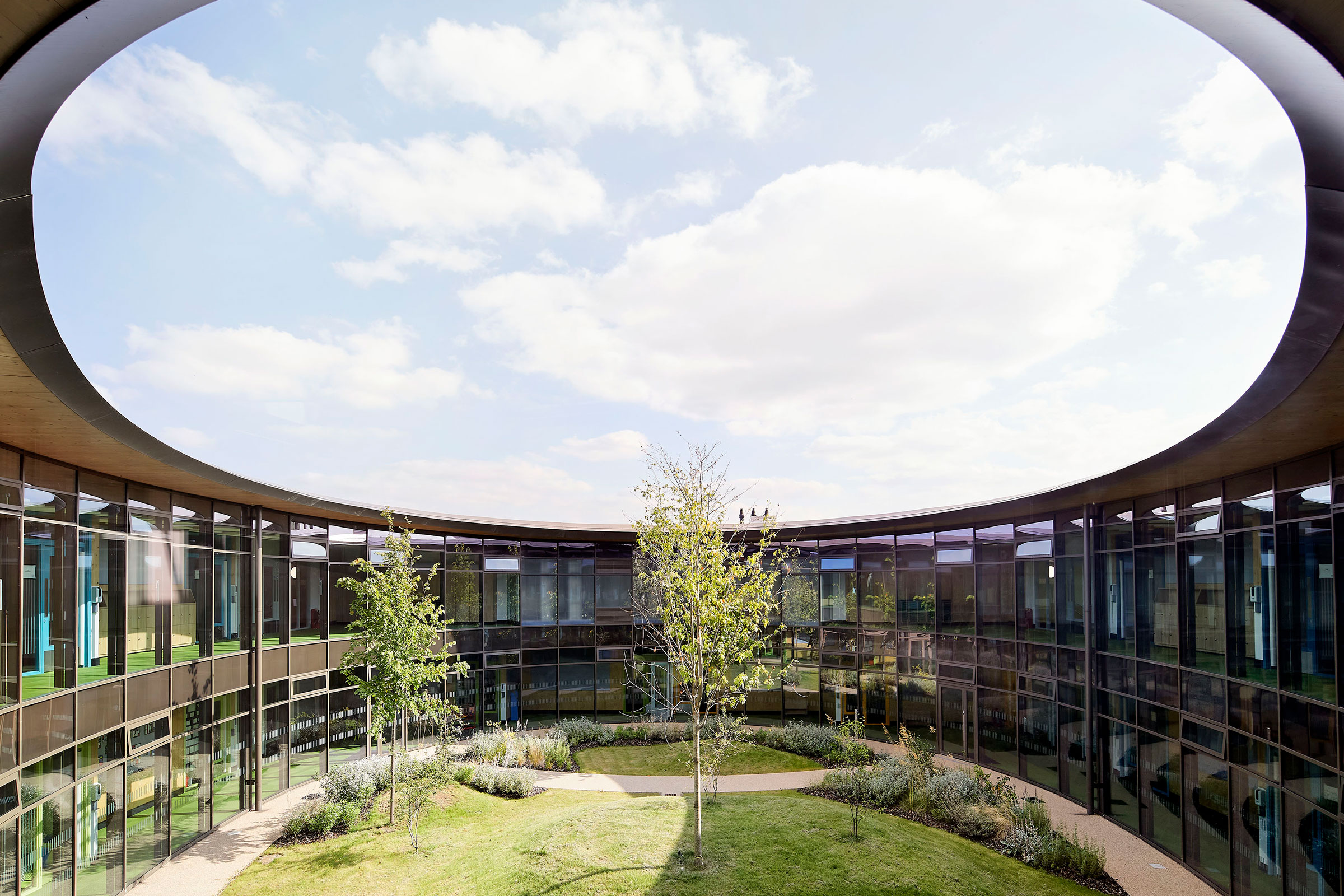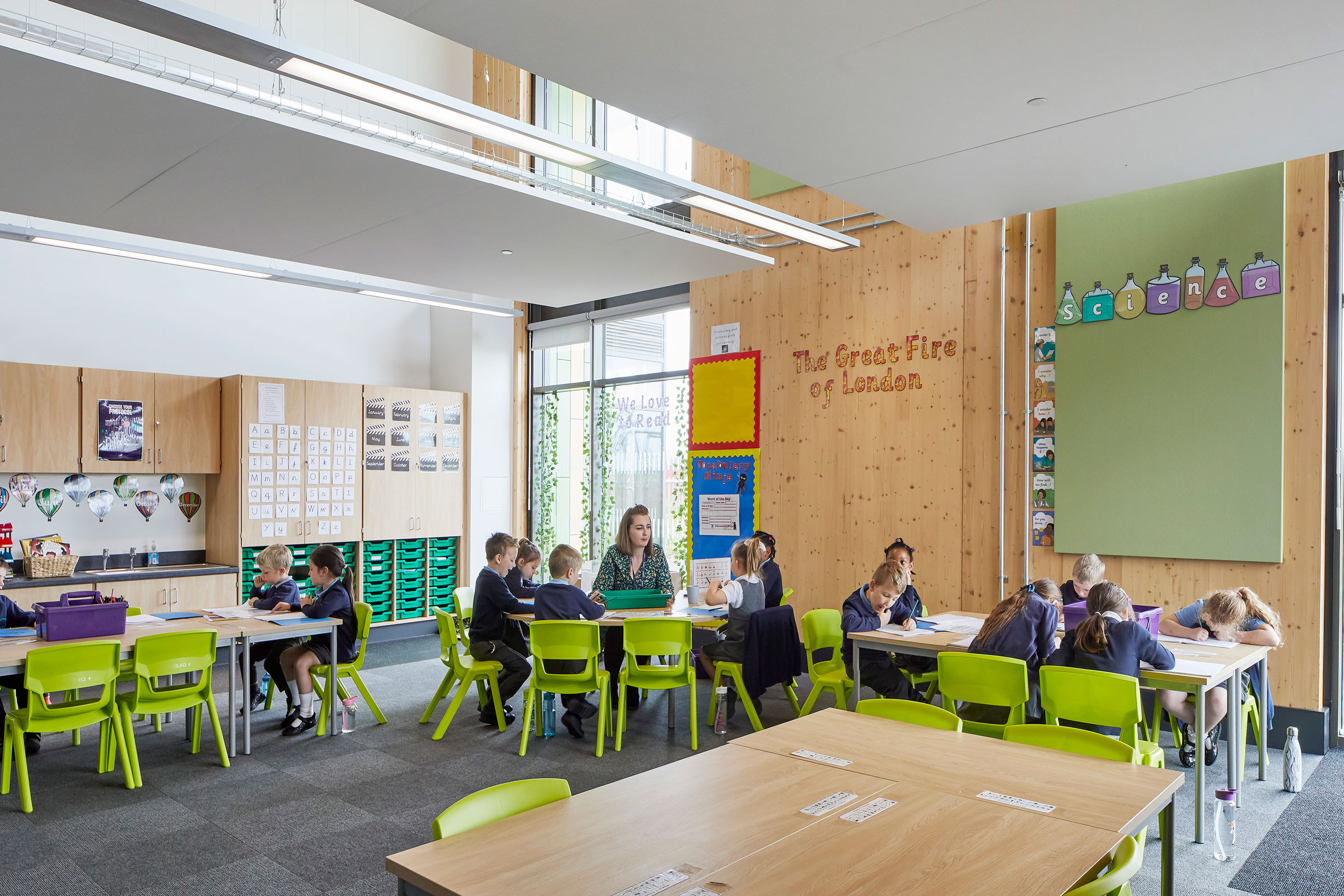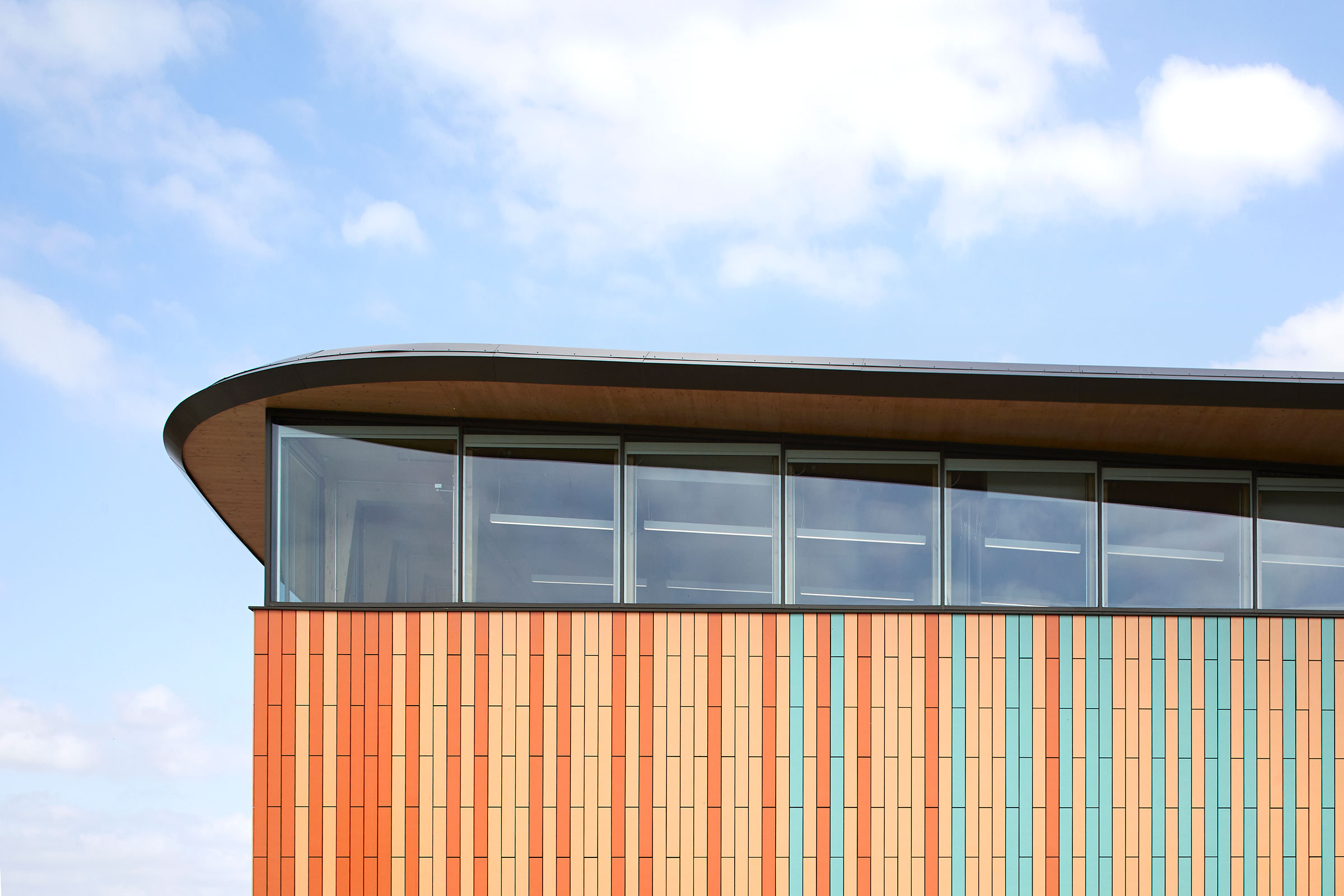Story at a glance:
- Wintringham Primary Academy is inspired by Forest School principles and designed for indoor and outdoor learning.
- With classrooms arranged around a woodland grove, the building is shaped like an avocado.
- The building uses cross-laminated timber and has half as much embodied carbon as a more traditional school.
If you take a train between London and Peterborough, you’ll pass by what looks like a colorful spaceship surrounded by farmland in a town called Wintringham. That building is a primary school that will soon become an anchor for a new development with thousands of homes and a civic square.
This building for Wintringham Primary Academy was designed by dRMM, who worked closely with the town’s developers and the school’s headmaster to execute the vision for the school. “We were involved from the inception of the masterplan stage,” says Philip Marsh, a founding director at dRMM.
It was important for the school to be located in the middle of the civic square. “It’s the one kind of place where a new community can come together,” Marsh says. A school brings lots of families together and deepens their connections. “You get to meet people that you wouldn’t normally meet. They’re going to foster neighborliness.”

At Wintringham Primary Academy, classrooms are arranged around a woodland grove, creating the building’s unique shape. The colors of the terra-cotta tiles around the school are inspired by the seasonal variation found in woodland forest and help with wayfinding. One side of the school faces an emerging civic square, while the other is a play area. Photo by Hufton+Crow Photography
Inspired by Forest Schools, dRMM was tasked with designing a school that had indoor and outdoor spaces for students to connect with nature. The two-story building centers around a woodland grove. Classrooms are arranged around the grove, and administrative buildings, a sports hall, and a community space are clustered around the northeast corner. This forms an avocado shape, with the grove as the pit. “It’s quite radical and quite progressive, but it’s also looking back to 19th century models of schools—a very simple school,” Marsh says.
It was very important for the indoor space to feel connected to the outdoor space. “There’s free flow from the classrooms into the landscape,” Marsh says. Classrooms on the ground level have doors that open directly to the outside, allowing teachers to easily extend their learning outdoors.

A landscaped courtyard known as the grove is a focal point of the school building. Photo by Hufton+Crow Photography
With the grove at the center, “the heart of the school is nature,” Marsh says. It is not merely landscape but also a teaching space. Students can learn about science and develop a connection to nature by being immersed in it. Students can also use that space to read, play, or do other activities.
The landscape architects designed a variety of outdoor spaces, including play areas, sports fields, and nature trails. They added more than 1,200 feet of native mixed hedgerow around the school’s perimeters as well as four acres of amenity grassland and wildflower meadows. They planted species like hornbeam, river birch, oak, and field maple that are beneficial to local wildlife. They also added bird boxes and raised planters, giving opportunities for students to interact with nature in a variety of ways.

The exposed timber brings an element of nature indoors and may benefit students’ health. Muted colors are used to limit stimulation, creating a more conducive learning environment. Photo by Hufton+Crow Photography
Following the school’s emphasis on nature and sustainability, the design of the building was built around the idea of “naturalness.” That made cross-laminated timber (CLT) the “intuitive choice” for the team at dRMM, who are pioneers in the material. Not only does it have a low carbon footprint, it also brings an element of nature indoors. The prefabricated pieces were easy to assemble onsite and minimized waste.
dRMM began using engineered timber in the early 2000s and are said to have designed the world’s first permanent hardwood CLT building. Clients are usually hesitant to use new materials, but “it’s exciting to have people who are excited about doing things slightly differently,” Marsh says.
The design team decided to leave much of the CLT exposed because it reduced the need for additional material, while adding a natural warmth to the space. Studies have also shown that wood in classrooms can reduce heart rates and stress levels for students.
“It’s brilliant to have a timber building, but we need to have longevity. It needs to last in excess of 50 to 60 years to get the real benefits,” Marsh says. Therefore, the team made sure the school was flexible to adapt for future needs. Instead of building fixed walls in classrooms, they used dividers that can be put up to create separate classrooms or removed to create a bigger classroom space.

The floor-to-ceiling windows provide natural light and a view of green space, making the hallways a comfortable place to spend time in. Photo by Hufton+Crow Photography
Many of the spaces were designed with multiple uses in mind. For example, the sports hall is also used as a cafeteria during lunch. With abundant light coming from the windows facing the grove, the interior hallways can also be used for different activities. To further increase the usable space in the hallways, the team decided to move lockers outside of the building under the roof overhang.
The roof is one of the many passive strategies used in this project. The overhang is wider toward the south side than the north side to allow for optimal lighting and shading. The glazed facade also strikes a comfortable balance between excellent daylight without excessive heat gain.
Classrooms were configured to minimize glare on whiteboards. Passive ventilation was used to the extent possible with cross ventilation from the exterior to the interior grove space through open vents in the facades. However, due to the school’s proximity to a high speed railway line, naturally ventilated heat recovery units were used to reduce background noise.

An energy-efficient envelope, passive ventilation strategies, and shading from the roof reduce energy consumption. Photo by Hufton+Crow Photography
The school building has less than half the embodied carbon as a more traditional school of the same size. Marsh says it’s an incredible feat, especially given that Wintringham Primary Academy is a public school. “There’s lots of potential to design something really exciting, but it’s quite limited in terms of its budget possibilities. So for us to design something as exciting as this in this kind of climate is fantastic,” he says.
Marsh says others can learn from this project. “Wintringham, in a way, should be the minimum requirement for schools, not the exception. A lot more schools in the UK can go follow these kinds of ideas.”



